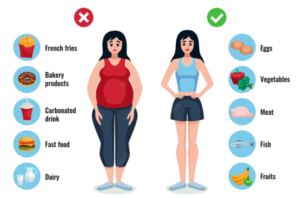Losing weight quickly can be a tempting goal, but it is crucial to approach this process safely and sustainably. Here are several steps and strategies that can help you achieve faster weight loss while minimizing health risks.

1. Set Realistic Goals
Aim for a weight loss of 1-2 pounds per week, which is considered safe and sustainable. This gradual approach helps ensure that you lose fat rather than muscle or water weight. Setting realistic goals also helps maintain motivation over the long term.
2. Create a Caloric Deficit
To lose weight, you need to consume fewer calories than your body burns. Calculate your daily caloric needs using an online calculator or consult with a healthcare professional. Aim for a deficit of 500-1000 calories per day to achieve the recommended weight loss rate.
3. Focus on Nutrient-Dense Foods
Prioritize foods that are low in calories but high in nutrients. Incorporate plenty of vegetables, fruits, whole grains, lean proteins (such as chicken, fish, beans), and healthy fats (like avocados and nuts) into your diet. These foods will help keep you full while providing essential vitamins and minerals.
4. Monitor Portion Sizes
Be mindful of portion sizes to avoid overeating. Use smaller plates, measure serving sizes, and pay attention to hunger cues. Eating slowly and savoring each bite can also help prevent overeating by allowing your brain time to register fullness.

5. Stay Hydrated
Drinking water can help control hunger and reduce calorie intake. Aim for at least 8 cups (64 ounces) of water per day, or more if you’re active or live in a hot climate. Sometimes thirst is mistaken for hunger; staying hydrated can mitigate this confusion.
6. Incorporate Regular Exercise
Combine dietary changes with regular physical activity to enhance weight loss efforts. Aim for at least 150 minutes of moderate aerobic exercise (like brisk walking) each week, along with strength training exercises at least twice a week to build muscle mass.
7. Consider Intermittent Fasting
Intermittent fasting involves cycling between periods of eating and fasting, which can help reduce calorie intake without requiring strict dieting rules. Common methods include the 16/8 method (fasting for 16 hours and eating during an 8-hour window) or the 5:2 diet (eating normally for five days and restricting calories on two non-consecutive days).
8. Seek Professional Guidance
Consulting with a healthcare provider or registered dietitian can provide personalized advice tailored to your individual health needs and goals. They can help create a structured plan that ensures you receive adequate nutrition while losing weight.

9. Build a Support System
Having support from friends, family, or weight loss groups can enhance motivation and accountability throughout your journey. Sharing experiences with others who have similar goals can provide encouragement and practical tips.
10. Track Your Progress
Keep track of what you eat and your physical activity using apps or journals to monitor progress effectively. This practice helps identify patterns in eating habits that may need adjustment.
By following these steps carefully, you can work towards losing weight safely while minimizing potential health risks associated with rapid weight loss methods.



